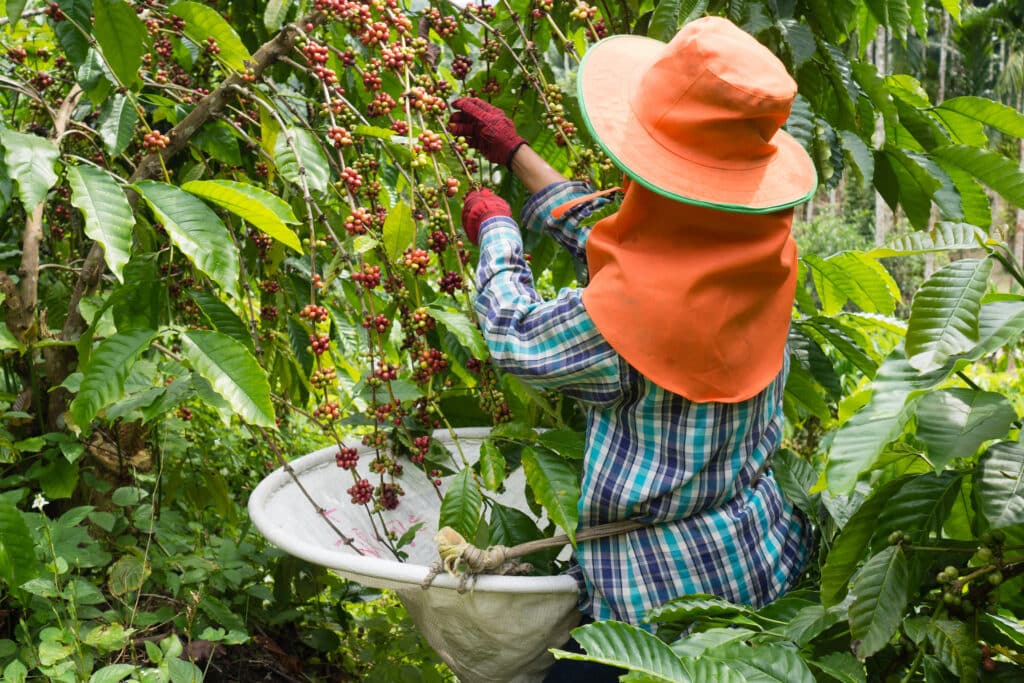
Photo: Coffee farmer harvesting coffee cherry. Credit @ Somka-ne Emawat, Shutterstock
On March 31, 2023, Verité in partnership with the Anker Research Institute, published the “Living Income and Living Wage Report: Rural Areas and Small Towns of Central Colombia. ”
In addition to providing a benchmark for the Colombian coffee sector, the study results provide a living wage and living income benchmark for a pilot project being carried out by Verité in Colombia under the U.S. Department of Labor-funded Cooperation On Fair Free Equitable Employment (COFFEE) Project. The project, implemented in collaboration with RGC Coffee, is piloting cost-effective, alternative, and complementary compensation approaches to identify the most effective interventions that improve workers’ well-being while also providing benefits for farmers.
The study concluded that the data collected on cost of living is sufficiently similar across the two distinct coffee-growing regions of Antioquia and Huila, which validates the use of a single living wage and living income benchmark for both regions. In fact, because the data was so similar across these two regions, the benchmarks will also likely be relevant for other nearby coffee-producing regions in Colombia. The report also revealed that the living wage in those regions is around 50% higher than the Colombian minimum wage. However, although coffee harvesters may earn close to a living wage during the harvest season, many workers depend on the income generated during the harvest to support their families for the whole year. This is an important distinction for the coffee sector as only around 5% of coffee workers are permanent workers with access to social protection and benefits.
Quinn Kepes, a Senior Director at Verité, said, “It is extremely helpful to have both a living wage and living income estimate so that we can determine how close we are able to get workers to earning a living wage by implementing alternative and complementary compensation approaches in Colombia, while at the same time taking into account the fact that farmers need to earn a living income to survive and thrive. We are only going to be able to develop replicable and scalable models if they are mutually beneficial for workers and coffee producers alike, increasing workers’ incomes while at the least not creating additional costs for farmers who are already struggling with fluctuating coffee prices and external pressures such as rising fertilizer costs and climate change.”
The final living wage and living income study is available on the Global Living Wage Coalition’s webpage. The study was funded by Keurig Dr Pepper and greatly benefited from the support of RGC Coffee and the Cooperativa de Caficultores de Salgar for the fieldwork. The research was led by the Anker Research Institute, a founding member of the Global Living Wage Coalition, which develops living wage and living income estimates in geographies and sectors worldwide using standardized, high-quality, and cost-effective methods.
Richard Anker, co-director of the Anker Research Institute and co-creator of the Anker Methodology to measure living wage, emphasized, “It is essential that action programs aiming to raise wages have a living wage estimate that is accepted by all stakeholders, including workers and employers. Therefore, internationally comparable and transparent living wage estimates are required given the global nature of the supply chain for coffee and other products. This publicly available report, presented to and discussed with stakeholders, is essential for taking action and stimulating public discourse on wages in Colombia and the global coffee supply chain.”
To learn more about the COFFEE Project, including our Colombia pilot project and our open-source toolkit and online training modules that seek to help companies identify, address, and prevent labor issues in coffee supply chains, please visit the COFFEE Project webpage.